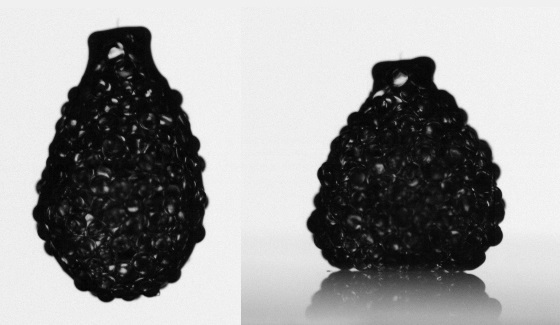See our article in Journal of Fluid Mechanics (2020)
The soft matter community has a good knowledge on the rheology of non-Brownian granular suspensions, from the linear Einstein’s law in the very dilute limit to more recent works in the very concentrated regime [1]. The law relating the effective viscosity to the solid fraction φ has been established experimentally and theoretically. The effective viscosity is Newtonian-like and increases with the solid fraction up to a critical value φc where it diverges, although φc is strictly less than the random packing fraction. This peculiarity is interpreted as a Reynolds dilatancy mechanism, where the particle assembly is jammed and has to dilate to be able to flow. However, the viscosity divergence is observed only at fixed volume, for exemple in a rheometer closed cell. In the case of “soft” boundaries, such as a free surface, things become more complex.
In our study, we focused on the deformation of a drop of concentrated suspension upon impact on a solid surface. The assumption that the laws established for viscous Newtonian fluids [2] also apply for viscous suspensions seems reasonable, and it was verified for solid fractions up to roughly 50% [3,4]. However, it obviously fails when φ > φc where no viscosity is defined.
From experiments covering a wide range of solid fractions, close to and even above the jamming fraction φc, and using particles of different sizes, we demonstrate how the dilatation of the particle pile in concentrated suspensions affects the deformation of the drops upon impact, even above the jamming fraction φc [4].
- F. Boyer, É. Guazzelli, and O. Pouliquen, Physical Review Letters, 107, 18 (2011)
- C. Josserand and S. T. Thoroddsen, Annual Review of Fluid Mechanics, 48, 1, (2016)
- M. Nicolas, Journal of Fluid Mechanics, 545 (2005)
- L. Jørgensen, Y. Forterre, and H. Lhuissier, Journal of Fluid Mechanics, 896 (2020)
